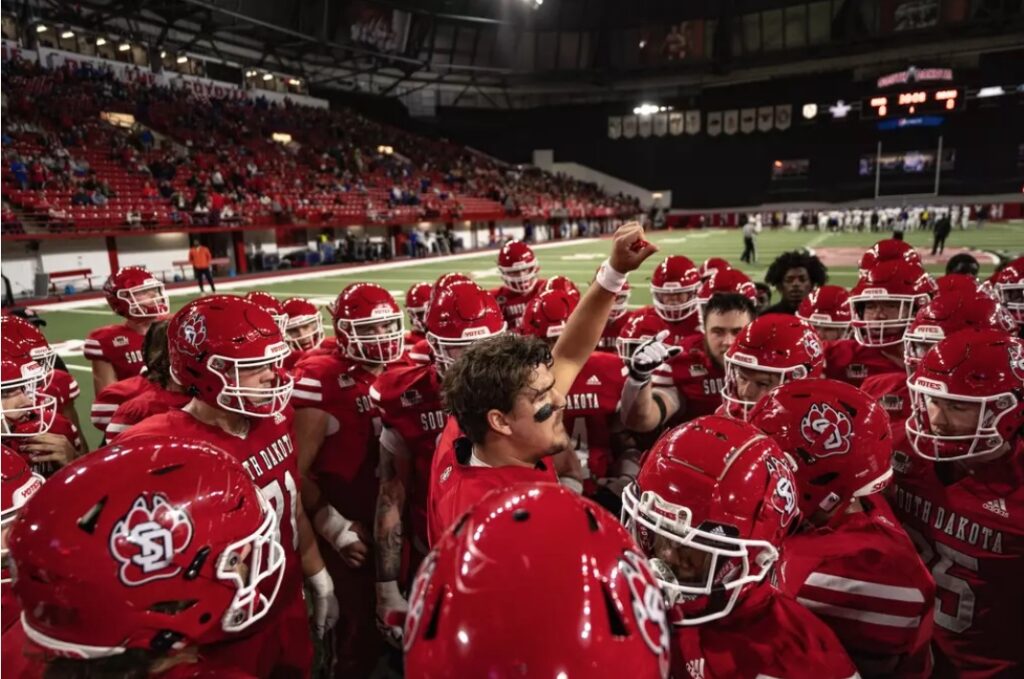
John Hult, South Dakota Searchlight
The NCAA unfairly favors large universities and disfavors female competitors with a proposed settlement that would regulate payments for student-athletes, according to South Dakota Attorney General Marty Jackley.
He filed a lawsuit Tuesday in Brookings County against the collegiate sports governing body. Jackley is representing the Board of Regents, which is pursuing the matter on behalf of the state’s two largest public universities, South Dakota State University in Brookings and the University of South Dakota in Vermillion. In an interview, Jackley said that together, the schools stand to lose around $1 million in NCAA revenue each year for 10 years under the settlement proposal.
South Dakota is an ideal venue for the legal challenge, he said. The state has none of the large schools the lawsuit claims will benefit unfairly under the settlement, but it does have two successful Division I athletics programs that would see fewer dollars from the NCAA under its terms.
That doesn’t put a combined challenge from multiple states – and perhaps a move to federal court – outside the realm of possibility.
“I can tell you that the complaint we filed today has been provided to other attorneys general, and I’ve been on the phone with other attorneys general all week,” Jackley said.
The NCAA did not immediately reply to a request for comment Tuesday.
Settlement hit snag prior to filing of SD lawsuit
The NCAA proposed the settlement in May to end three class action lawsuits over athlete compensation.
The May settlement’s origins can be traced back to a 2021 decision from the U.S. Supreme Court, which sided with a lower court in its conclusion that the NCAA’s prohibition on athlete compensation was a violation of antitrust laws.
The NCAA had previously held that student athletes could not profit from their name, image or likeness (NIL), even as the NCAA and schools themselves reaped the financial rewards of broadcast deals, advertising and merchandising.
Even after the Supreme Court ruling, the NCAA barred institutions from paying student athletes directly, rather than through benefits like scholarships.
The proposed settlement would allow schools to pay students up to a limit, but it’s yet to be approved. The agreement has been on hold since last week, when a judge in Northern California told negotiators to “go back to the drawing board” to address the NCAA’s desire to restrict “booster collectives.”
Collectives emerged to connect college athletes with NIL opportunities in the absence of direct payments from schools. South Dakota’s Division I schools have collectives supported by their athletic programs but officially independent of them.
U.S. District Judge Claudia Wilken declined to offer preliminary approval to the settlement after a hearing last Thursday, in part because it would allow the NCAA to restrict the ways collectives can make payments. Judge Wilken wanted that part of the agreement removed, according to reporting from ESPN, but the NCAA argued that the restrictions are central to the agreement.
South Dakota concerns: Fairness, breach of financial duty
Concerns for smaller schools will remain regardless of the outcome of those settlement talks, Jackley said. That’s because, he argues, the NCAA’s framework for settling the case violates its fiduciary duties to schools outside the “Power Four” conferences like the Big 10.
The proposal sets aside $2.8 billion to compensate former and current athletes. NCAA reserves would pay around $1.15 billion; the remaining $1.65 billion would come through reduced NCAA disbursements to the organization’s 1,100 member universities over the next decade.
There are 365 Division I schools. According to the NCAA, they split around $600 million of the disbursed revenue. In the settlement, the 68 schools in the Power Four – a group that includes schools like Alabama or Texas A&M that saw the greatest financial benefit from the work of amateur athletes – would cover around 40% of reductions over the next decade. The other 60% of the lost revenue burden would be shouldered by the remaining Division I schools.
South Dakota schools fall into that second category, but the schools aren’t alone in their concerns. Administrators of smaller schools have spent months pondering how the settlement might affect their operations. Some even said they might need to consider dropping down to Division II to cope financially, according to reporting from the New York Times-owned outlet The Athletic.
In July, Jackley told another sports news outlet called Sportico he was considering a lawsuit in the interest of South Dakota’s two Division I universities.
The lawsuit argues that the settlement would do unjust financial damage to smaller schools. It also alleges that the agreement violates federal Title IX rules on equitable treatment for male and female athletes by funneling 90% of the payments to male athletes, and that the NCAA violated its own constitution by entering into a settlement without a two-thirds vote of its member schools.
Jackley competed in track and cross country for the South Dakota Mines while pursuing his undergraduate degree in engineering.
“As a former college student-athlete, I believe strongly in a system that presents our athletes with opportunities to compete and treats all of our athletes fair and equal,” Jackley said in a news release on the lawsuit. “I am disappointed that our South Dakota athletes and universities are paying the price for a settlement that did not involve any of our conduct.”
If the settlement falls apart and a jury hands a win to the plaintiffs in the class action lawsuit, Jackley said, the NCAA decisions that inspired the lawsuit will still need to be addressed.
“I’m open to conversation with them, but they need to fix two things, and it’s not the one or the other,” Jackley said. “They need to fix the treatment of the smaller schools, which include SDSU and USD, and they need to fix the treatment of female student athletes.”
